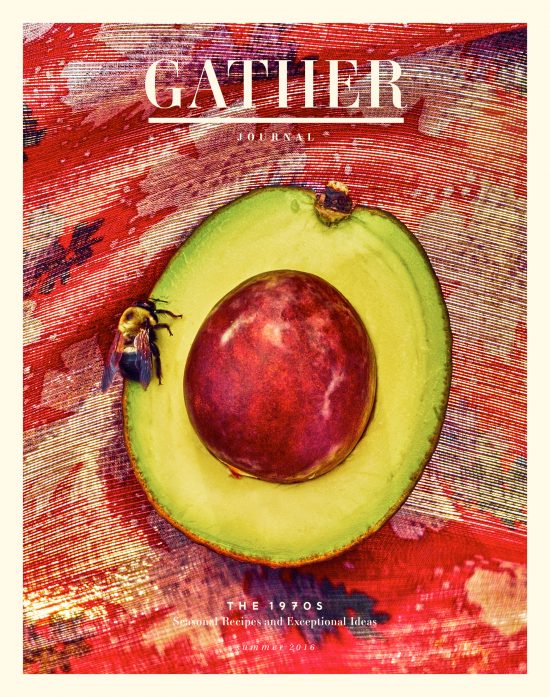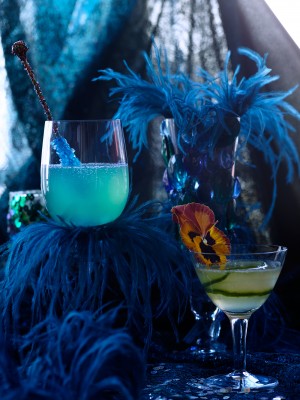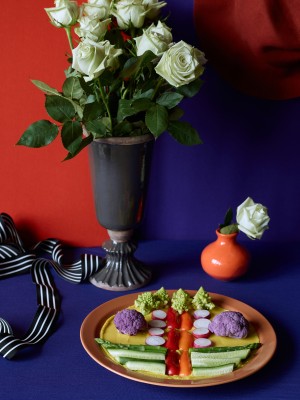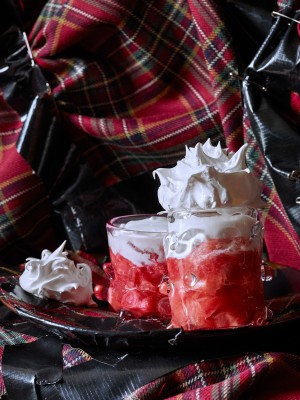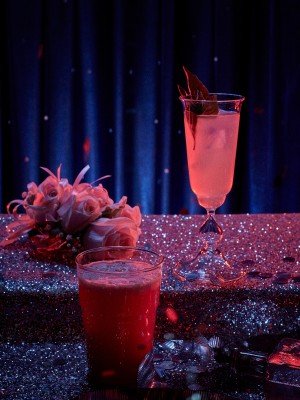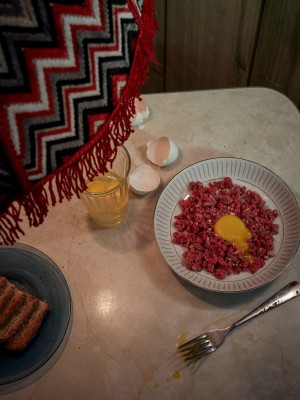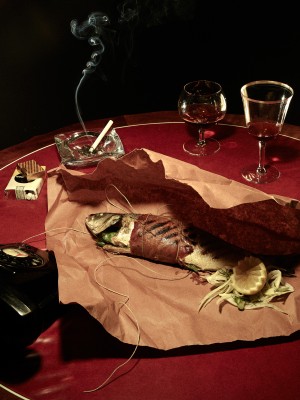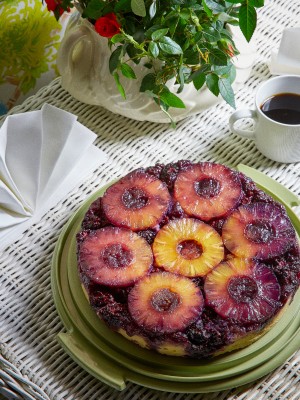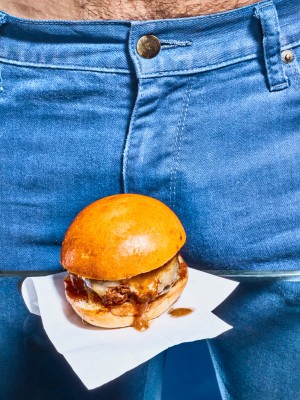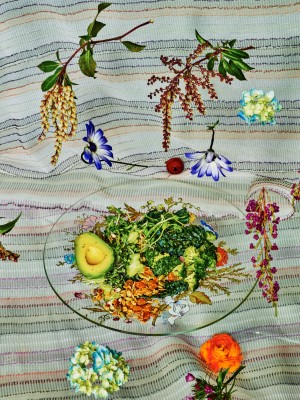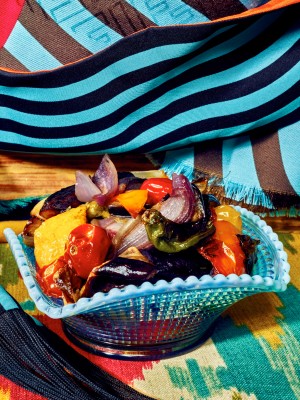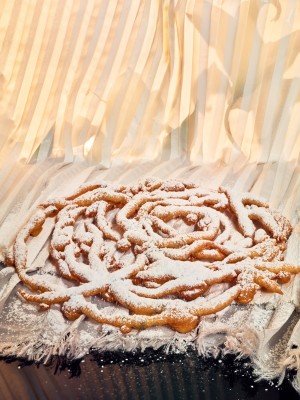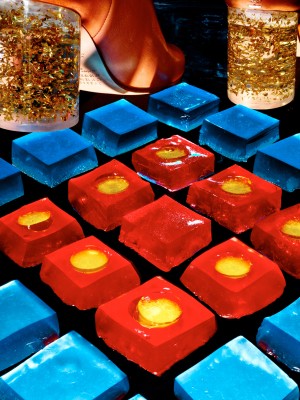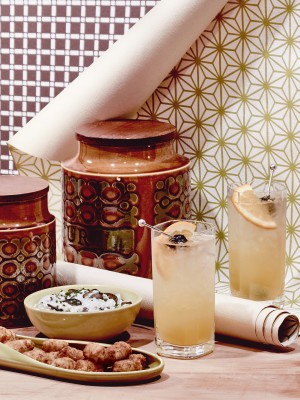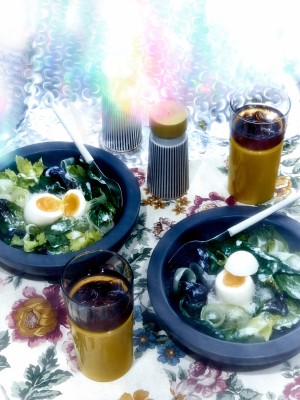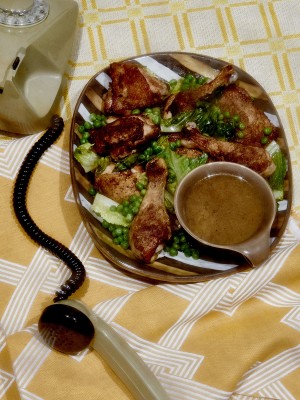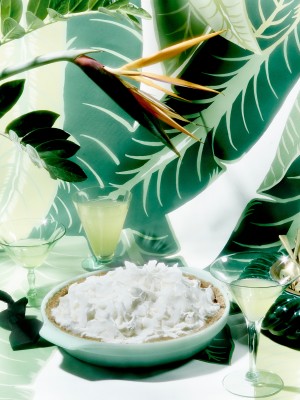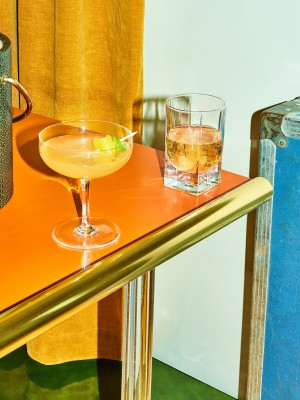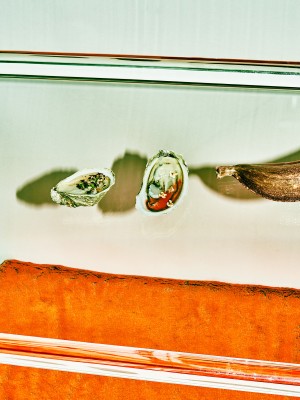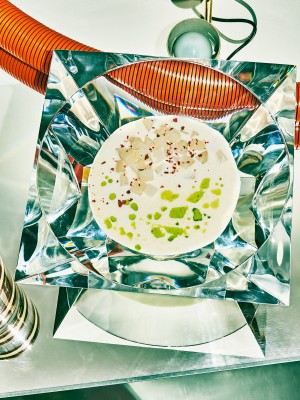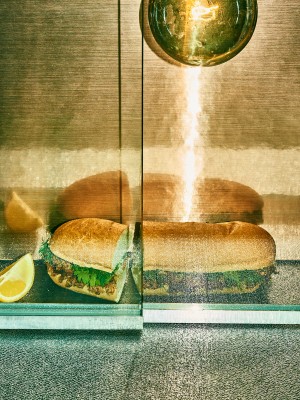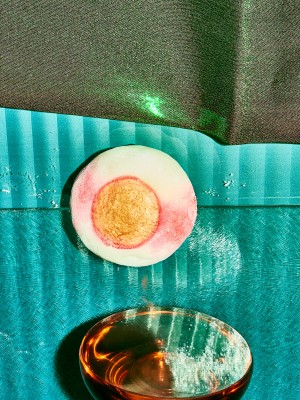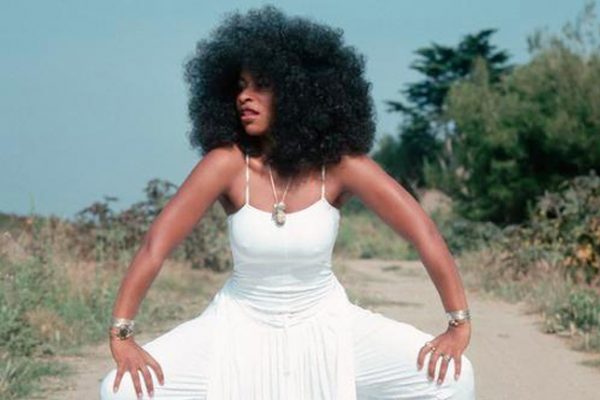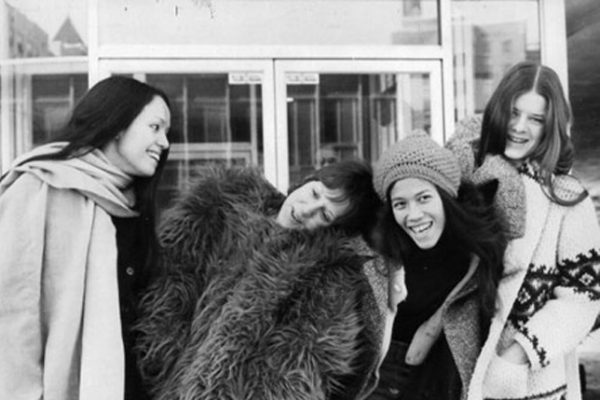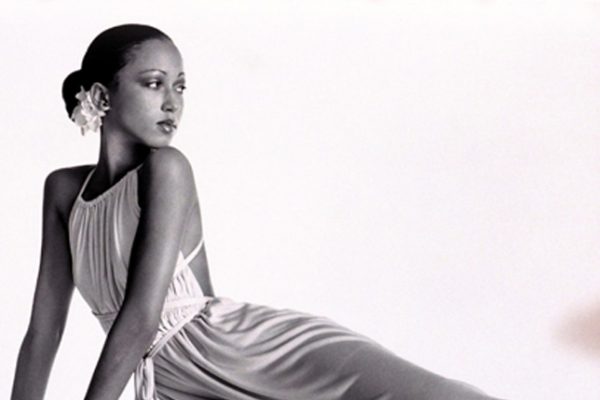The summer 2016 issue of Gather Journal turns back time to the 1970s. Chapters, and their accompanying menus, are arranged by genre: television, music, film, style, and one dedicated to David Bowie who is really a genre unto himself. There’s a sweet feature on the iconic hairstyles of the 1970s, and a story about the golden era of porn, complete with a sexy fruit centerfold (peel it out and pin it up). You’ll also find text musings on everything from the cookbooks that defined the decade to the crockpot, the genius of Norman Lear to the short-lived, but much-loved Viva magazine.
Cover: Photograph by Grant Cornett, Food and Prop Styling by Janine Iversen
Anything goes: the mantra for ’70s style. Feminism coincided with the emergence of trousers as the “dress for success” staple for working women, and environmentalism inspired a surge in crafty details like crochet. Fashion became a means of escape, as designers plundered exotic influences, and two music genres (disco, in all its hedonistic glory; and punk, brooding and dangerous) had a disparate but distinct impact. And film acted as both a conduit and harbinger for trends: The Great Gatsby and Cabaret spurred on ’20s and ’30s revivals; and Mahogany and Klute had the wardrobes of ’70s dreams. One common thread: a desire for individualism.The Me Decade! Our stylish dishes—a color-blocked crudité with turmeric dip; a draped uni pasta; a fish with far-flung details; and a syllabub with prickly meringue, designed with outliers in mind—distinguish themselves from the masses.
The ’70s were the decade of the director as auteur and provocateur; perhaps the last era when the vision of luminaries like Cassavetes and Coppola and Scorsese, Woody Allen and Hal Ashby, Robert Altman and Terence Malick, trumped the agendas of studios. There is, in turn, a purity and humanity and grit to the films that emerged; they are often as untidy as people’s lives were then. Disillusionment was in the air, and this was reflected on-screen, where the outsider, the radical, the square peg was memorialized. Our menu—a delicate duo of tea sandwiches, a finely-chopped steak tartare, a prosciutto-swaddled branzino, an anise-laced, pineapple blackberry upside-down cake—pays tribute to a small serving of the decade’s films. Each one a breakthrough.
Sound. That’s what began to evolve in the ’70s. The Grateful Dead built their behemoth Wall of Sound (70 tons of speakers, tweeters, and tube amps imagined by their LSD chemist Owsley Stanley); artists like Giorgio Moroder and Emerson, Lake & Palmer employed the new generation of Moog synthesizers to mind-bending effect; and Panasonic’s Technics SL-1200MK2 turntable decks opened up a world of playback possibilities for DJs. The ’70s would also birth entire genres—disco, punk, hip-hop, new wave—much of it consumed on vinyl in this pre-Walkman golden era of the album. Our music menu is made for repeat play: juicy sliders; an earthy salad of avocado and sprouts; summer vegetable ratatouille; a gelatin rainbow; and a funnel cake doused with powdered sugar.
“It’s only an idiot box if an idiot is watching it.” True words from Archie Bunker, patriarch of Norman Lear’s trailblazing, boundary-busting sitcom All in the Family. TV’s first wave of significance (and radicalism) came in the ’70s. Comedian Carol Burnett became the first woman to host her own variety show (30 million people tuned in weekly); Mary Tyler Moore put a face to the growing number of women in the workforce; we got our first taste of reality TV with the Watergate trials; M.A.S.H went to Vietnam; Maude had an abortion; and landmark mini-series Roots cast sitcom dad Mr. Brady as a slave owner. It’s no wonder then that legions of people were staying in, to tune in. Our TV dinner—crunchy mushroom and onion dip; a far-out egg salad; “jiggled” chicken legs and thighs with lettuces and peas; and a tropical coconut cream pie—is also worth staying in for.
“Who is he? What is he? Where did he come from? Is he a creature of a foreign power? Man? Woman? Robot?,” asked Dick Cavett when he introduced David Bowie on a 1974 episode of his show. In an era when many yearned for a break from reality, Bowie was escapism incarnate. And for a generation looking on, Bowie’s exploration of gender fluidity (before that was even a term) and image would serve as reassurance of their own—each of his transformations reinforcing the hope that all of us could change too. When he passed this year, it was in his lyrics, written so many years ago, that we found solace. From Hunky Dory’s “Quicksand”: “Knowledge comes with death’s release. I’m not a prophet or a stone age man, just a mortal with potential of a superman. I’m living on.” His spirit lives on in our Bowie menu—a duo of high-concept oysters; a cool potato and “butter-milk” soup; a cabbage schnitzel hero; and a gleaming mound of mochi ice cream.
Contributors
Chrissie Abbott
The London-based designer, art director, and artist likes to say that she creates tangible versions of alternate realities, dreams of nature, and internal theories of the apocalypse. Her medium: a mix of collage, pen and ink, acrylic, and silkscreen printing, while her technicolor animated films use pattern work and found images. Abbott’s clients include ASOS, Adidas, Nike, Vans, Gap, The New York Times, Wallpaper, Sony BMG and the Ace Hotel.
A ’70s food or drink ripe for a comeback: I feel like Spam is about to come back in a big way. And I’ve always kind of loved the logo.
Will Anderson
The Brooklyn-based photographer from Newcastle Upon Tyne, England, trained as a graphic designer before getting behind the lens. He has published a number of books (Apt. 301, Garden), including his most recent, Death in a Good District. His favorite shoots are always for Gather. See his work at willandersonphotography.com.
A ’70s food or drink ripe for a comeback: Knickerbocker Glory ice cream
Angharad Bailey
Bailey, who spent most of her formative years country-hop- ping, has her dad (a first-wave recycler and repurposer who never missed a flea market or car boot sale) to thank for her obsessive-level love of objects. The New York-based stylist is an associate editor for LADY magazine and her clients include Clinique, Frye, Harper’s Bazaar, Condé Nast Traveler, and Kate Spade Saturday. Stories she has styled have been the recipient of numerous SPDs and American Photography awards. See her work at angharadbailey.com.
A ’70s food or drink ripe for a comeback: Jell-O. I don’t like the taste or texture but I love the crazy shapes, layered colors, and odd food you can put in them.
Lauren Cierzan
The Nashville-based writer and illustrator’s work most recently appeared in Lenny Letter. See more of her work at laurencierzan.com and @laurencierzan on Instagram.
A ’70s food or drink ripe for a comeback: My vote goes to Baked Alaska. My personal 2016 goal is successfully making my own. Meringue can be tricky business.
Grant Cornett
Photographer Cornett resides in the Catskills, with his beautiful wife Janine, lovely youngest daughter Georgia, and two standard poodles.
A ’70s food or drink ripe for a comeback: Ham and banana hollandaise
Molly Findlay
The stylist and set designer grew up between Northern California and the Mojave Desert, daughter of free-spirited parents with a love of craft. Findlay, who now calls upstate New York home, has worked with a host of renowned photographers and her clients include The New York Times Magazine, Italian Vogue, Harper’s Bazaar, Elle, Gucci, Levi’s, Coach, Kate Spade and MAC. Findlay is also the co-founder, with husband Everard, of the Mother of Thousands Art Collective, a group of wildly creative artists and designers whose most recent project was taking over the Bergdorf Goodman windows.
A ’70s food or drink ripe for a comeback: Fondue!
Meagan Getz
An illustrator and graphic designer for nearly two decades, Getz’s projects run the gamut from t-shirt design to medical drawings. Her favorite medium is watercolor and she does all of her sketching in simple pen plucked, she says, from her kitchen drawer. Getz currently lives in Virginia with her husband, four sons, and a Turkish Van cat. Her hope is always that her illustrations will make people smile.
A ’70s food or drink ripe for a comeback: Whole artichokes. My dad would boil them and then we would pluck off each leaf and dip it in Miracle Whip until you got down to the heart, which was the prize.
Laura McLaws Helms
Born in Manhattan and raised in London, Helms holds degrees from NYU’s Tisch (in photography and Russian studies), FIT (an MA in fashion and textile studies) and the London College of Fashion (a PhD in fashion history). An accomplished fashion and cultural historian, Helms is the co-founder of LADY and acts as an exhibition curator and design consultant to stylists, editors and designers. In 2015 Helms curated an exhibition on Thea Porter at London’s Fashion & Textile Museum, wrote an accompany- ing monograph (Thea Porter: Bohemian Chic, published by V&A), and is currently co-producing a feature-length film on Porter. Helms is the recipient of a 2011 Lucie Award (with Kohle Yohannan).
A ’70s food or drink ripe for a comeback: Gelatin molds. If you use healthier ingredients (coconut milk over condensed) and superfoods (like chia, acai) they would be the ideal dessert for now. Otherwise, I believe more restaurants should have shrimp cocktail.
Beth Hoeckel
The Baltimore-born artist earned a degree from the prestigious School of the Art Institute of Chicago where she studied painting, printmaking, and photography; her medium of choice nowadays is mixed media painting and collage. Hoeckel has also lent her talents to a number of bands (album art) and magazines like Bust, Oprah, Wired, Lucky Peach, and Rookie, where she is the staff illustrator. See her work at bethhoeckel.com.
A ’70s food or drink ripe for a comeback: Piña coladas
Gentl and Hyers
Partners in photography and life, Andrea Gentl and Martin Hyers met while students at Parsons. Focused on food, travel, interiors, and portraits, their clients include Condé Nast Traveler, Coqui Coqui, and Häagen-Dazs. The pair recently taught a visual storytelling photography workshop
in the high mountains of Peru. See their work at gentlandhyers.com.
A ’70s food or drink ripe for a comeback: Martin: I think the Salty Dog is ready for another round. I’m having a Pavlovian reaction just saying the name. Andrea: Mateus Rose or Martini & Rossi on the rocks... say yes!
Janine Iversen
Iversen is an artist working in New York. See her work at janineiversen.com and janineiversen.cc.
A 70s food or drink ripe for a comeback: Steak tartare and Long Island Ice Tea... though not together.
Stephen Kent Johnson
New York-based photographer Johnson has shot for Rizzoli, WSJ Magazine, and New York magazine. See his work at stephenkentjohnson.com.
A ’70s food or drink ripe for a comeback: Cheeseballs. Nonstop cheeseballs.
Stacey Mark
Mark logged time as a studio assistant for Steven Klein, as the photo director at Nylon magazine, and a photo researcher at Vogue before turning her attention to photography full-time. Her collaboration with actress Asia Argento led to her first solo show, Some Girls Wander by Mistake. Mark’s clients include Purple, Lula, Russh, LADY, and Vice. See her work at staceymark.com.
A ’70s food or drink ripe for a comeback: Cool Whip on anything and everything. And Sanka.
Samantha Muljat
The German-born artist earned a degree in photography and a masters in graphic design from the University of Art and Design Offenbach am Main. Now based in L.A. Muljat is the art director at Southern Lord Recordings where notable clients have included Earth, Grave Pleasures, Goatsnake, Today is the Day, and Red Mountains. Communication Arts magazine described her style as “finding a mystical potential in the Western landscape.”
Katy Peetz
Gather’s co-recipe editor made her way to New York from Nebraska to attend culinary school at the International Culinary Center. After graduating Peetz worked in some of the city’s most notable kitchens, on both the pastry and savory sides. She was named one of Zagat’s 30 Under 30 Star Chef’s Rising Star Pastry Chef before stepping into the world of recipe development and food styling. Peetz was most recently the associate food editor at Tasting Table. See her work at katypeetz.com.
A ’70s food or drink ripe for a comeback: What I would like to see come back is the elaborate attention given to party-planning in the ’70s beyond the recipes. I’m talking illustrations of buffet table layouts, hostess responsibilities, budget tips, and napery.
Jess Rotter
The New York-born, L.A.-based artist’s work is informed by a deep knowledge and love for the world of 1970s rock ’n’ roll. First inspired by her dad’s vinyl covers and comic books, Rotter’s intricately beautiful, psychedelic hand-drawn illustrations have appeared on everything from public murals (Ace Hotel) to album covers (Best Coast). Other clients include Lenny Letter, Indiewire, MTV, Converse, Light in the Attic, Red Bull, and Pitchfork Review. Her cult favorite musical t-shirt label, Rotter and Friends, which she launched in 2006, led to collaborative collections with The Gap and Urban Out tters. Rotter has had solo exhibitions in New York, L.A., Marfa, and Tokyo. Her rst book, I’m Bored (Hat and Beard Press), will be out this fall.
A ’70s food or drink ripe for a comeback: Harvey Wallbanger, a cocktail that also sounds like an old friend
Maggie Ruggiero
Gather’s food stylist and co-recipe editor entered the gastronomical world after selling her East Village bar and using the proceeds to attend culinary school. She logged time in some of the city’s most esteemed restaurant kitchens before shifting her focus to food styling and recipe development. See her work at maggieruggiero.com.
A ’70s food or drink ripe for a comeback: My mom’s sukiyaki chicken party should never come back. Never.
Matthew Zoller Seitz
Editor-in-chief of rogerebert. com and TV critic for New York magazine, Seitz’s work has been a nalist for the Pulitzer Prize in criticism. The Brooklyn-based writer and lmmaker’s 2009 video essay “Wes Anderson: The Substance of Style” was turned into the book The Wes Anderson Collection. Seitz is also the founder and original editor of The House Next Door (now a part of Slant magazine) and the publisher of Press Play, a blog of lm and TV criticism and video essays. Seitz is the director of the 2005 rom-com Home and the forthcoming sci-fi epic Rabbit of the Sith. He is currently writing a memoir titled All the Things that Remind Me of Her.
A ’70s food or drink ripe for a comeback: The diet platter I used to always see people ordering when I was a kid with a scoop of cottage cheese on a bed of lettuce, a couple of slices of pineapple, and a hamburger patty.
Martyn Thompson
The New York-based image maker created avant-garde clothes before deciding to document them instead, working as a fashion photographer in Paris before moving to London, where his scope broadened to include interiors and still lifes. Author of Interiors and Working Space: An Insight into the Creative Heart, he recently launched Martyn Thompson Studio, creating textiles, murals, and other works based on his photographs. See his work (and sign up for his newsletter) at martynthompsonstudio.com.
A ’70s food or drink ripe for a comeback: I miss chips with lots of salt and vinegar wrapped in newspaper.
Keirnan Monaghan & Theo Vamvounakis
Keirnan & Theo have been collaborating for well over a decade. They were married in 2009, but it wasn’t until this year that they became an artistic team. While they shoot mostly set-centric still life, they also enjoy creating portraits, as well as landscapes. Their clients include W magazine, Vogue, Barney’s New York, Marie Claire, and WSJ. See their work at keirnanandtheo.com.
Jessie Kanelos Weiner
The Chicago-born, Paris-based illustrator, food stylist and author is best known for her vibrant watercolor illustrations and fine-line coloring books. Weiner’s work has appeared in Vogue, T magazine, Le Nouvel Observateur and M Le Magazine du Monde. Her latest book Edible Paradise: A Coloring Book of Seasonal Fruits and Vegetables (Rizzoli’s Universe Imprint), explores the edible plant kingdom. Weiner also writes and illustrates a popular blog about her life, thefranco y.com. See her work at jessiekanelosweiner.com.
A ’70s food or drink ripe for a comeback: The cheese log
Amy Wilson
Born in California and raised in a barn in Pennsylvania, Wilson got her start as a financial reporter before becoming the style editor at Real Simple. Now a prop stylist, her clients include Bon Appétit, William Sonoma, West Elm, Condé Nast Traveler, Whole Foods, and Vanity Fair. Wilson has worked on the books Bringing Nature Home and the recent Gjelina cookbook. She also works as a garden designer with The Organic Gardener, focusing on rooftops and other urban spaces. See her work at amyelisewilson.com.
A ’70s food or drink ripe for a comeback: I think egg punch seems like it should be back in rotation.
